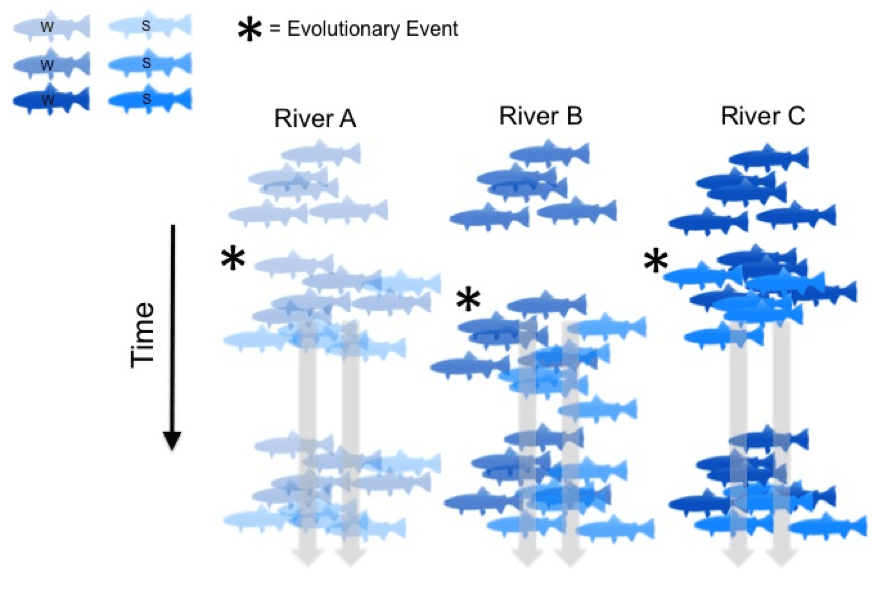Friday November 27, 2015

Steelhead in the Pacific Northwest show diversity in their run timing, or the timing of when the fish migrate from saltwater to freshwater. Populations of summer-run and winter-run steelhead enter their natal rivers at different time periods, but spawn at roughly the same time. Summer-run steelhead return to the rivers in the summer or early fall, and wait to spawn until the winter or spring (similar to the spring-run Chinook salmon life history). Winter-run steelhead enter their natal rivers much later than summer-run (during winter months), but spawn at the same approximate time period. Since the two runs enter the river at different times, they typically spawn in different areas of the river, and therefore do not spawn with each other. This means that two runs of fish within the same river basin are ‘reproductively isolated’ from each other (are not interbreeding), and evolution can therefore influence each population separately. However, this diversity in run timing that we see in rivers today does not provide any information about this diversity originally arose, which is important to know for managing different runs under the Endangered Species Act.
There are two primary ways that different run timings may have evolved in steelhead, and these two mechanisms predict differences in which groups of fish we would expect to be most closely related to each other. Conceptual diagram #1 shown above depicts an imaginary population and shows how a new run timing may have evolved through a single evolutionary event (denoted with an asterisk). Through time, winter-run steelhead in each river remain as a single population (light gray arrows). However, a single evolutionary event (e.g., the development of a new trait, like a difference in run timing) occurs on river B, creating a population of summer-run steelhead. Through time, this population of summer-run steelhead persists in river B and spreads out to colonize other rivers (dark gray arrows). If this scenario were true, we would expect all summer-run populations (in rivers A, B, and C) to be more closely related to each other than to any of the winter-run populations.
 The second conceptual diagram shows an alternative way that multiple run-timings may have evolved. This diagram of an imaginary population depicts the process of parallel evolution, or multiple, independent evolutionary events (denoted with asterisks). In each river, the winter-run population evolves into two separate populations (light gray arrows), one with early run timing (summer-run) and one with later run timing (winter-run). Because the summer-run population diverged from the winter-run population in each specific river, if this scenario were true we would expect the summer-run population in river A to be more closely related to the winter-run population in river A than to other summer-run populations in rivers B or C. Observing this type of result in genetic studies would support the hypothesis of parallel evolution. One of our biologists participated in a recently published research study that investigated which of these mechanisms holds true for steelhead in California and Oregon – that is, did differences in run timing evolve one time or many times? Stay tuned to find out which process the study revealed!
The second conceptual diagram shows an alternative way that multiple run-timings may have evolved. This diagram of an imaginary population depicts the process of parallel evolution, or multiple, independent evolutionary events (denoted with asterisks). In each river, the winter-run population evolves into two separate populations (light gray arrows), one with early run timing (summer-run) and one with later run timing (winter-run). Because the summer-run population diverged from the winter-run population in each specific river, if this scenario were true we would expect the summer-run population in river A to be more closely related to the winter-run population in river A than to other summer-run populations in rivers B or C. Observing this type of result in genetic studies would support the hypothesis of parallel evolution. One of our biologists participated in a recently published research study that investigated which of these mechanisms holds true for steelhead in California and Oregon – that is, did differences in run timing evolve one time or many times? Stay tuned to find out which process the study revealed!
